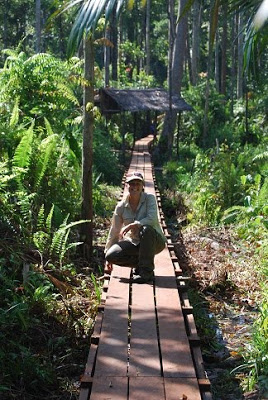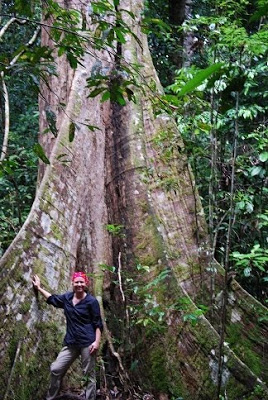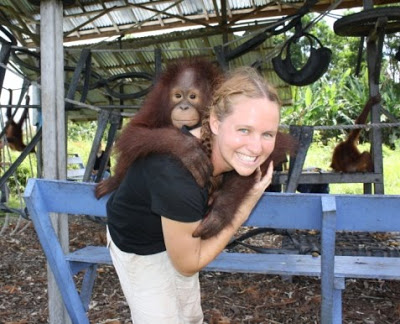Note – Jessica Parker, CSU Human Dimensions of Natural Resources graduate and former intern for CNHP, has moved on to her dream job helping with orangutan rehabilitation efforts in Indonesia. Here is an update from her regarding all the great work she has been doing. If you would like to read more, be sure to check out Jessica’s blog. Thanks for the update, Jessica, and keep up the good work!
Hello! Since leaving CNHP in May, I have had many new adventures while working for Orangutan Foundation International in Kalimantan, Indonesia. During the month of June, I was part of a dynamic volunteer team from around the globe that built a new bridge between one of the pondoks, housing young rehabilitant orangutans, and the surrounding peat swamp tropical rainforest. In just three weeks, our team of inexperienced workers built over 250 meters of bridge out of locally grown ironwood! You may ask how a bridge is contributing the conservation of orangutans. Well, indirectly, the bridge is a critical part of the rehabilitation process that will help to return over 300 young orangutans to the wild and contribute to the long term survival of the orangutan species. How? The bridge extends the amount of forest that the rehabilitants have access to during “jungle school,” where they learn critical survival skills including the identification and processing of food, arboreal locomotion, and social interaction. After we finished our work, our group had tears in our eyes as we watched the first group of orangutans tumble down the bridge, racing towards the forest and a future in the wild.

Since the completion of the bridge, I have been working as the Environment Enrichment Fellow at the Orangutan Care Center and Quarantine (OCCQ) in Pasir Panjang. What does this work entail? In short, the goal of enrichment is improving the quality of life for captive animals through the provision of novel objects and manipulation of their environment. For primates, enrichment can be summed up as trying to be smarter than they are; we often wonder if we are enriching the orangutans or they are enriching us! I am providing enrichment for 75 orangutans, a playful Malaysian sun bear, and a beautiful cassowary, and they are providing me with an unforgettable glimpse into the lives of some of Indonesia’s most charismatic and endangered species.

There are more than 320 orangutans at the rehabilitation center and enrichment is a vitally important tool in the survival toolbox, stimulating the complex learning process that can take more than seven years in the wild. For most of the orangutans, enrichment consists of daily trips to the 80 hectare forest surrounding the facility. The orangutans at the veterinary pondok where I work often cannot participate in these trips to the forest due to a variety of reasons, such as physical disabilities, so they are given special enrichment within their enclosures. Every day, we hand out truckloads of acacia branches to stimulate foraging, nest building, and play. Well, those are the activities we hope to encourage but the orangutans have some of their own ideas. The acacia fruit makes the orangutans foam at the mouth and they spend several enjoyable minutes rubbing the soapy fluid up and down their arms before they gleefully slurp it off. Others use the branches as very stylish headwear and walk around like Roman gods with wreaths of acacia rather than olive leaves. The most mischievous use the branches as whips as they hang from the top of their enclosures and assail their comrades with occasional whacks across the back.
We also make swings and hammocks from recycled tires and plastic barrels, which keep the hairy orange residents physically and mentally active as they romp and learn how to dismantle our work. Locally produced rattan balls are filled with peanuts and raisins, creating a puzzle for the young orangutans to solve. Tool production and use are encouraged by smearing the inside of PVC pipes with peanut butter. Branches must be carefully selected, stripped of leaves, and then used to scrap off the sticky treat. Miniature scavenger hunts are created by hiding popcorn and raisins under the orangutan night nests. The older ones merely raise their eyebrows at this game as if asking if we really thought they did not know where we hid the goodies.

The younger orangs and those that are convalescing from illness, malnutrition, or surgery are given thick towels for comfort and warmth, towels that can be used as cloaks, nest liners, food holders, seat cushions, and tents. It is always enjoyable to walk through the special care section and see a whole host of dark eyes gazing at you from under different colored security blankets. In addition to the emotional and cognitive enrichment that we are providing, nutritional enrichment has also become a focus of my work for the special care orangutans that have suffered from malnutrition, anemia, depression, etc. Their daily fruit diet is supplemented by fortified milk, eggs, peanuts, and raisins to provide additional vitamins, minerals, calories, protein, and fat. The results are already evident: there has been an increase in activity, appetite, and overall health in many of these orangutans. For example, Ulin, a small twelve year old female who had suffered from severe malnutrition in captivity, would not eat and spent most of her time curled up in a ball in a lethargic stupor. She has become a new orangutan, eating a wide variety of foods, interacting with other orangutans during her outings, and building nests each night inside her tire swing. She recently became a Colorado Rockies Fan after we found an official Rockies towel in town for her! Now that she has been elevated to royal status, she arranges her branches and towel into a towering nest that she lazily lays on, feeding herself with her feet; Queen Ulin at your service!
I feel a tremendous sense of accomplishment when I look at Ulin and see how my enrichment work has vastly improved her quality of life. Today, we took her for a walk and she spent the majority of her time at the top of a tall tree, foraging on fruit and leaves and gazing into the distance. Is she thinking what we are thinking about the future of her species in the wild? We will never know but what we do know is that Ulin is an ambassador for her species, an ambassador that reminds us of the importance of our work: to orangutans, to biodiversity, and to the entire planet.




